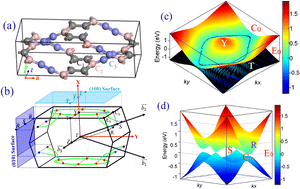A predicted orthogonal semimetallic carbon with negative thermal expansion and compressibility†
Abstract
Carbon has many allotropes possessing unique properties. In this work, we predicted an orthogonal carbon crystal, named ort-C24, with dynamic, mechanical and thermodynamic stability. Studies indicate that it is a topological semimetal having both nodal rings and nodal lines in its Brillouin zone. Ab initio molecular dynamics simulations reveal that it is a rare material having a negative thermal expansion coefficient along the a axis. It also has negative compressibility along the same axis under hydrostatic pressure. Its b axis can bear an astonishing strain of 115% even if the dynamical stability is considered. Tensioning along different axes can either change it into a metal or alter the nodal ring into nodal lines or only modify the shape of the nodal ring, together with the variation of the number of Dirac cones. Theoretically, temperature has a limited influence on its electronic topological properties while a hydrostatic pressure of 5 GPa can alter it noticeably. The simulated X-ray diffraction peaks indicate the possible existence of ort-C24 in carbon soot. These adjustable electronic topological properties may provide us with an interesting platform for studying such topological semimetals.



 Please wait while we load your content...
Please wait while we load your content...